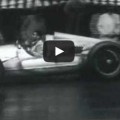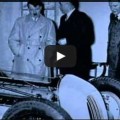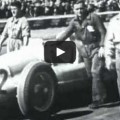In 1962 Hermann Lang came back to the Nürburgring to drive his Mercedes W125 Grand Prix car again. The 1937 Mercedes W125 Data: 8-Cylinder In-line 5,660 CC 646 bhp at 5,800 rpm (The most powerfull gp car ever built up until the late seventies)
The video below showcases Hermann Lang at Nürburgring.
Born in the Cannstatt district of Stuttgart, Baden-Württemberg, Germany, at age fourteen Hermann Lang had to go to work to help support his family following the death of his father. Young Lang found a job as a motorcycle mechanic, eventually buying his own used bike with which he began amateur racing. He won the very first race he entered and before long decided to compete in the sidecar class. At age twenty-two, he won the German sidecar mountain race championship.
Lang’s big break came when he landed a job at the Mercedes factory where he became part of their Grand Prix motor racing team. He was made head mechanic for the Mercedes-Benz W25A model to be driven by the Italian star Luigi Fagioli who had left Alfa Romeo to create a powerhouse Mercedes factory team that also included Rudolf Caracciola. Following a very successful season in which Fagioli won both the Italian and Spanish Grand Prix, Hermann Lang was given a chance to drive for the Mercedes team. He proved to be most capable on high-speed racetracks, capturing his first win in the 1937 Tripoli Grand Prix at the Mellaha Lake course in Libya which was then the fastest racetrack in the world. Lang dominated the event, winning it for three straight years. That year he won his second major race at the AVUS extravaganza.
In 1938, he won two more races for Mercedes including the prestigious Coppa Ciano at Livorno, Italy. Nevertheless, in spite of Hermann Lang’s skills and racing success and his popularity with racing fans, being a part of the Mercedes Silver Arrows team was not easy. Made up of wealthy and aristocratic drivers who looked down on the uneducated, working-class Lang, he was always treated as an outsider. However, in 1939 he earned their grudging respect when he won five of the eight Grand Prix races he started, including victories at the Belgian Grand Prix, the Pau Grand Prix in France, the Swiss Grand Prix and his third consecutive Tripoli Grand Prix. He clocked the fastest lap at the French Grand Prix and was leading the field but engine trouble knocked him out of the race. In 1939, Lang also competed in, and won, the Kahlenberg hillclimbing race in Austria.



